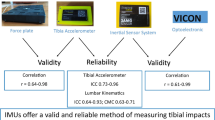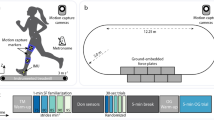Abstract
Within-field variability of surface characteristics has been found to impact athlete injuries, performance, and perceptions about a surface. Ankle-worn inertial measurement units allow for in-situ research exploring how within-field variability influences athlete biomechanics. This study investigated the effect of force reduction within-field variability on peak tibial accelerations of male collegiate rugby athletes. High and low force reduction areas were delineated within one natural turfgrass and synthetic turf field. Athletes were fitted with wearable inertial measurement units and executed three activities (drop landing, drop jump, and modified acceleration–deceleration) within each area. Peak tibial accelerations (m/s2) were compared between areas within field types for each activity using t tests (α = 0.05). Peak tibial accelerations were significantly higher (p < 0.05; d = 0.36 and d = 0.61 for natural turfgrass and synthetic turf, respectively) in low force reduction areas on both field types (natural turfgrass = 201.0 ± 7.1 m/s2 and synthetic turf = 248.0 ± 8.7 m/s2, mean ± SE) during the drop landing activity compared to the high force reduction areas (natural turfgrass = 182.3 ± 5.9 m/s2 and synthetic turf = 220.5 ± 6.4 m/s2). Peak tibial accelerations were significantly higher in low force reduction areas during the initial landing of the drop jump on natural turfgrass (178.9 ± 6.1 and 202.9 ± 6.1 m/s2 for high and low force reduction area, respectively; p < 0.01; d = 0.61), but not synthetic turf (p = 0.95; d = 0.01). No differences were detected between areas or field types with the second landing of the drop jump or modified acceleration–deceleration activities. These findings suggest that within-field variability affects biomechanics of athletes when performing certain athletic maneuvers, which has important implications on sports field management.







Similar content being viewed by others
Data availability
Data are available upon request.
References
Stiles VH, James IT, Dixon SJ, Guisasola IN (2009) Natural turf surfaces: the case for continued research. Sports Med 39:65–84. https://doi.org/10.2165/00007256-200939010-00005
Jastifer JR, McNitt AS, Mack CD et al (2019) Synthetic turf: history, design, maintenance, and athlete safety. Sports Health 11:84–90. https://doi.org/10.1177/1941738118793378
Hales ME, Johnson JD 2nd (2019) The influence of sport-field properties on muscle-recruitment patterns and metabolic response. Int J Sports Physiol Perform 14:83–90. https://doi.org/10.1123/ijspp.2018-0004
Potthast W (2010) Motion differences in goal kicking on natural and artificial soccer turf systems. Footwear Sci 2:29–35. https://doi.org/10.1080/19424280903535447
Meyers MC (2010) Incidence, mechanisms, and severity of game-related college football injuries on FieldTurf versus natural grass: a 3-year prospective study. Am J Sports Med 38:687–697. https://doi.org/10.1177/0363546509352464
Ammar A, Bailey SJ, Hammouda O et al (2019) Effects of playing surface on physical, physiological, and perceptual responses to a repeated-sprint ability test: natural grass versus artificial turf. Int J Sports Physiol Perform 14:1219–1226. https://doi.org/10.1123/ijspp.2018-0766
Dickson KH, Straw CM, Thoms AW, et al (2021) Impact of third generation synthetic turf athletic field age on surface hardness and infill depth spatial variability. Proc Inst Mech Eng P J Sport Eng Technol https://doi.org/10.1177/17543371211002947
Straw CM, Carrow RN, Bowling WJ et al (2018) Uniformity and spatial variability of soil moisture and irrigation distribution on natural turfgrass sports fields. J Soil Water Conserv 73:577–586. https://doi.org/10.2489/jswc.73.5.577
Straw CM, Grubbs RA, Henry GM (2020) Short-term spatiotemporal relationship between plant and soil properties on natural turfgrass sports fields. Agrosyst Geosci Environ 3:e20043. https://doi.org/10.1002/agg2.20043
Forrester SE, Tsui F (2014) Spatial and temporal analysis of surface hardness across a third-generation artificial turf pitch over a year. Proc Inst Mech Eng P J Sport Eng Technol 228:213–220. https://doi.org/10.1177/1754337114523756
Straw CM, Samson CO, Henry GM, Brown CN (2018) Does variability within natural turfgrass sports fields influence ground-derived injuries? Eur J Sport Sci 18:893–902. https://doi.org/10.1080/17461391.2018.1457083
Straw CM, Principe FM, Kurtz EL, et al (2020) Within-field variability of turfgrass surface properties and athlete performance: modeling their relationship using GPS and GIS technologies. Proc Inst Mech Eng P J Sport Eng Technol 234:170–175. https://doi.org/10.1177/1754337119901090
Straw CM, Henry GM, Shannon J, Thompson JJ (2019) Athletes perceptions of within-field variability on natural turfgrass sports fields. Precis Agric 20:118–137. https://doi.org/10.1007/s11119-018-9585-2
Mears AC, Osei-Owusu P, Harland AR et al (2018) Perceived links between playing surfaces and injury: a worldwide study of elite association football players. Sports Med Open 4:40. https://doi.org/10.1186/s40798-018-0155-y
Ferris DP, Liang K, Farley CT (1999) Runners adjust leg stiffness for their first step on a new running surface. J Biomech 32:787–794. https://doi.org/10.1016/s0021-9290(99)00078-0
Schrier NM, Wannop JW, Lewinson RT et al (2014) Shoe traction and surface compliance affect performance of soccer-related movements. Footwear Sci 6:69–80. https://doi.org/10.1080/19424280.2014.886302
Qu H, Zhang S, Sorochan JC et al (2022) Effects of synthetic turf and shock pad on impact attenuation related biomechanics during drop landing. Sports Biomech 21:748–760. https://doi.org/10.1080/14763141.2019.1690570
Camomilla V, Bergamini E, Fantozzi S, Vannozzi G (2018) Trends supporting the in-field use of wearable inertial sensors for sport performance evaluation: a systematic review. Sensors 18:873. https://doi.org/10.3390/s18030873
Fleming P, Watts C, Gunn J, Forrester S (2020) Hardness safety testing of artificial turf. MDPI Proc 49:130. https://doi.org/10.3390/proceedings2020049130
IRB (2020) IRB Artificial Rugby Turf Performance Specification: Technical Document
Krivoruchko K, Gribov A (2019) Evaluation of empirical Bayesian kriging. Spat Stat 32:100368. https://doi.org/10.1016/j.spasta.2019.100368
Getis A, Ord JK (2010) The analysis of spatial association by use of distance statistics. Geogr Anal 24:189–206. https://doi.org/10.1111/j.1538-4632.1992.tb00261.x
Armitage M, Beato M, McErlain-Naylor SA (2021) Inter-unit reliability of IMU Step metrics using IMeasureU Blue Trident inertial measurement units for running-based team sport tasks. J Sports Sci 39:1512–1518. https://doi.org/10.1080/02640414.2021.1882726
Burland JP, Outerleys JB, Lattermann C, Davis IS (2021) Reliability of wearable sensors to assess impact metrics during sport-specific tasks. J Sports Sci 39:406–411. https://doi.org/10.1080/02640414.2020.1823131
Lesinski M, Prieske O, Beurskens R et al (2018) Effects of drop-height and surface instability on jump performance and knee kinematics. Int J Sports Med 39:50–57. https://doi.org/10.1055/s-0043-117610
Harper DJ, Morin J-B, Carling C, Kiely J (2020) Measuring maximal horizontal deceleration ability using radar technology: reliability and sensitivity of kinematic and kinetic variables. Sports Biomech. https://doi.org/10.1080/14763141.2020.1792968
Prieske O, Muehlbauer T, Krueger T et al (2015) Sex-specific effects of surface instability on drop jump and landing biomechanics. Int J Sports Med 36:75–81. https://doi.org/10.1055/s-0034-1384549
Virtanen P, Gommers R, Oliphant TE et al (2020) SciPy 1.0: fundamental algorithms for scientific computing in Python. Nat Methods 17:261–272. https://doi.org/10.1038/s41592-019-0686-2
Vallejos R, Osorio F, Bevilacqua M (2020) Spatial relationships between two georeferenced variables: with applications in R. Nature Springer, New York, NY, USA
Schloerke B, Cook D, Larmarange J, et al (2021) GGally: Extension to “ggplot2”
R Core Team (2020) R: A language and environment for statistical computing. R Foundation for Statistical Computing, Vienna, Austria
Hope RM (2013) Rmisc: Ryan Miscellaneous
Morey RD (2008) Confidence intervals from normalized data: a correction to Cousineau (2005) Tutor Quant Methods Psychol 4:61–64. https://doi.org/10.20982/tqmp.04.2.p061
Wickham H (2016) ggplot2: Elegant graphics for data analysis. Nature Springer, New York, NY
Nunome H, Inoue K, Ball K et al (2020) High load stress-strain property of natural turf for professional use, various types of natural, hybrid and artificial turfs in football. MDPI Proc 49:142. https://doi.org/10.3390/proceedings2020049142
Caple M, James I, Bartlett M (2012) Mechanical behaviour of natural turf sports pitches across a season. Sports Eng 15:129–141. https://doi.org/10.1007/s12283-012-0096-5
Binnie MJ, Dawson B, Pinnington H et al (2014) Sand training: a review of current research and practical applications. J Sports Sci 32:8–15. https://doi.org/10.1080/02640414.2013.805239
Saunders N, Twomey D, Otago L (2011) Clegg hammer measures and human external landing forces: is there a relationship? Int J Sports Sci Eng 5:231–236
Matijevich ES, Branscombe LM, Scott LR, Zelik KE (2019) Ground reaction force metrics are not strongly correlated with tibial bone load when running across speeds and slopes: Implications for science, sport and wearable tech. PLoS One 14:e0210000. https://doi.org/10.1371/journal.pone.0210000
Hollville E, Nordez A, Guilhem G et al (2020) Surface properties affect the interplay between fascicles and tendinous tissues during landing. Eur J Appl Physiol 120:203–217. https://doi.org/10.1007/s00421-019-04265-9
Arampatzis A, Stafilidis S, Morey-Klapsing G, Brüggemann G-P (2004) Interaction of the human body and surfaces of different stiffness during drop jumps. Med Sci Sports Exerc 36:451–459. https://doi.org/10.1249/01.mss.0000117166.87736.0a
Acknowledgements
The authors would like to acknowledge Brian Carey, CSFM, SSC Services for Education at Texas A&M University, and the Texas A&M University Club Rugby team for their assistance and participation in the study.
Author information
Authors and Affiliations
Corresponding author
Ethics declarations
Conflict of interest
The authors declare that they have no conflict of interest.
Additional information
Publisher's Note
Springer Nature remains neutral with regard to jurisdictional claims in published maps and institutional affiliations.
Supplementary Information
Below is the link to the electronic supplementary material.
Rights and permissions
Springer Nature or its licensor (e.g. a society or other partner) holds exclusive rights to this article under a publishing agreement with the author(s) or other rightsholder(s); author self-archiving of the accepted manuscript version of this article is solely governed by the terms of such publishing agreement and applicable law.
About this article
Cite this article
Burbrink, C.M., Straw, C.M., Floyd, W.F. et al. Influence of force reduction within-field variability on peak tibial accelerations using wearable inertial measurement units. Sports Eng 26, 44 (2023). https://doi.org/10.1007/s12283-023-00435-3
Accepted:
Published:
DOI: https://doi.org/10.1007/s12283-023-00435-3




